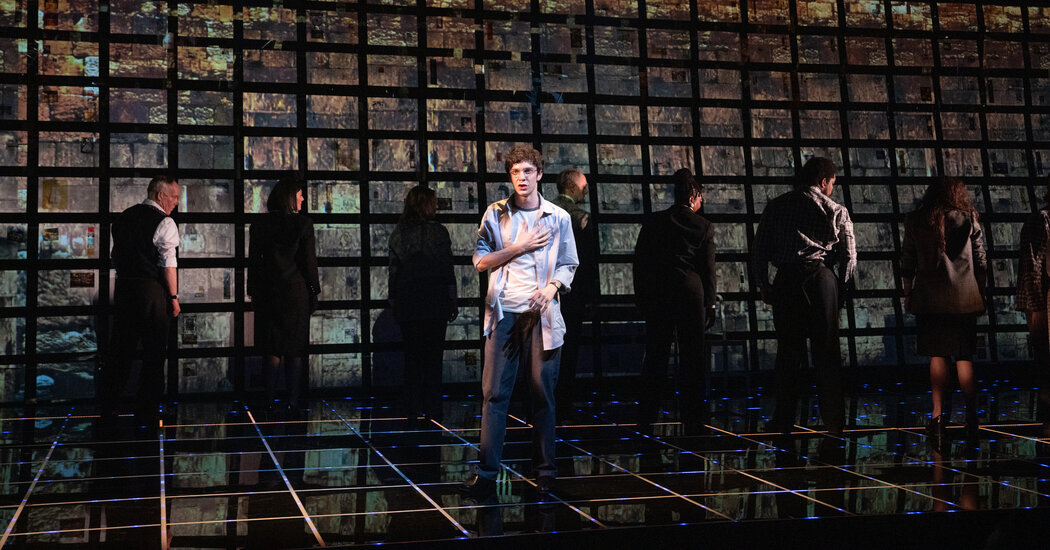If you’re even a little sensitive to signs of sociopathy, you’d peg Ethan Dobson right away. Someone at the start of a promising career in journalism who is so aggressively flattering and greasily evasive, with a snap-on, snakelike, aw-shucks smile, has got to have a scheme up his sleeve. Or rather, in Ethan’s case, a dangerous bunch of lies in his pocket.
To ask why the editors of such an obvious fabulist don’t catch him until they’ve published at least six of his articles, each one a long, lurid and uncheckable fantasy, is to ask why the editors of The New Republic took so long to catch Stephen Glass doing much the same thing. Or why the editors of Rolling Stone took so long to catch Sabrina Erdely; USA Today, Jack Kelley; The Washington Post, Janet Cooke; and The New York Times, Jayson Blair.
They didn’t want to.
That’s the most intriguing idea to emerge from “The Connector,” a murky new musical about journalistic fabrication that opened on Tuesday at MCC Theater. It sees Ethan (Ben Levi Ross) as the beneficiary of a long history of male editorial vanity that sentimentalizes its past and falls for the excesses of New Journalism over old facts. That makes Conrad O’Brien (Scott Bakula) — the head of a prestigious monthly called The Connector — an easy mark; when he takes Ethan under his handsomely graying wing, he thinks he’s securing his glorious legacy when actually he’s destroying it.
But that animating idea is also a problem because aside from Jason Robert Brown’s typically propulsive songs, which excite even the most absurd moments of Jonathan Marc Sherman’s book, the engine of the story, set in the 1990s, depends on uncertainty about Ethan’s veracity. That’s a nonstarter. After just one meeting at the magazine, a young copy editor and frustrated writer named Robin (Hannah Cruz) is already suspicious: “I’m watching you map the boundaries,” she sings, in a number that also serves as a vaguely romantic red herring. And the magazine’s “fact-checking legend,” Muriel, played by Jessica Molaskey, sees right through him even faster.
So do we, and we quickly lose interest.
That’s not the fault of the beamish, resourceful Ross, who, as a recent Evan Hansen, has experience portraying liars. Here, though, he has little to play; not pinning Ethan down is how “The Connector,” conceived and directed by Daisy Prince, keeps itself moving forward. This leaves the show devoid of psychology — the most important thing a musical might have added to the already well-covered histories of journalists who make stuff up. It helped, if you believed him, that Jayson Blair, after his deceptions were discovered, explained that he suffered from bipolar disorder.
But Ethan? We have no idea. The worst impediment we learn about him, in a song called “So I Came to New York,” is that he’s from a place where “everyone’s a scumbag”: New Jersey.
In the same song we learn that Robin is from a place where “everyone’s an asshole”: Texas. Though she and Ethan bond over their parallel tracks to the big city, their trajectories once there are inevitably different. Robin, both a woman in a man’s world and a Latina in a white one, watches with mounting incredulity as Ethan’s star rises while hers stays put. “Half the stories of the world are left unwritten,” she sings in a bravura number called “Cassandra.”
Positioning Robin as an unheeded prophetess and an eventual participant in Ethan’s undoing is a smart way to explore the sexism of the media world at the time. But positioning her as Ethan’s maybe-girlfriend — as if in obeisance to and at the same time defiance of some foundational rule of musical theater — undoes that work. She’s finally as opaque as Ethan.
Brown’s score, often big, loud and thrillingly sung, goes some distance toward addressing that systemic problem by squashing it. But unlike the shapely, strongly hooked songs he wrote for “Parade,” “The Last Five Years,” “13” and “Honeymoon in Vegas,” many of those in “The Connector” meander, as if looking for a point, or to avoid one.
Particularly problematic are the numbers that illustrate Ethan’s subjects, including a flamboyant Greenwich Village Scrabble shark, a Black “off-the-books political operative” and a group of pilgrims to the Western Wall in Jerusalem. In what I hope is meant to suggest the falseness of these stories, Brown pounds the pastiche in the songs so hard it borders on minstrelsy: hip-hop for the fixer; fiddle schmaltz for the pilgrims.
If this is satire, like “The Lifespan of a Fact,” a much lighter treatment of a similar subject, it sits uncomfortably with the chic, swift seriousness of Prince’s staging, on a set by Beowulf Boritt, darkly lit by Jeanette Oi-Suk Yew, that consists mostly of magazine page proofs and towering stacks of manuscripts. The same tonal ambiguity destabilizes Sherman’s book, which accurately sets up the paranoia of the period — when conglomerates stripped legacy media properties for parts as the internet ate up their readership — but then goes too far. The multinational taking over The Connector is the consonant cluster VorschlagXE. Its top priority is repainting the office walls turquoise.
“Vorschlag” means “suggestion” in German, and I wish “The Connector” had taken that hint. Subtlety would help the audience understand how to read it. As it stands, we are so far ahead of the story that even the good parts feel like filler.
In a way, that makes sense, given Ethan’s puffed-up prose. The samples offered are purple and banal, hardly living up to Gabriel García Márquez’s witticism about similar fabrications. It was unfair, García Márquez wrote, that Cooke’s Washington Post article about a (nonexistent) 8-year-old heroin addict won a Pulitzer Prize for journalism — but just as unfair that it did not win one for fiction.
In other words, what in a newspaper is lying may be style in a novel. “The Connector,” as perhaps its title means to imply, wants to stake out the gray space in between. This is where Conrad, the editor in chief, thinks journalism must live: “We are not purveyors of facts, we are tellers of truths,” he sings in what amounts to a mission statement for the magazine and the musical. Not buying that fatuous distinction, Muriel, whom Molaskey handily makes the most complex character among a crowd of cartoons, offers a rebuttal in what may be the only ode to fact-checking ever written. “I’ll believe in god when I see her,” she sings. The song is called “Proof.”
“The Connector” might have benefited from Muriel’s dedication to detail. (You can’t play more than seven letters at a time in Scrabble.) Yet in the end the problem with the musical isn’t the unconvincing rendition of the world of journalism or even the pesky little errors. The problem is its lack of perceptible human insight. It doesn’t need a fact checker so much as a fabulist.
The Connector
Through March 17 at MCC Theater, Manhattan; mcctheater.org. Running time: 1 hour 45 minutes.


